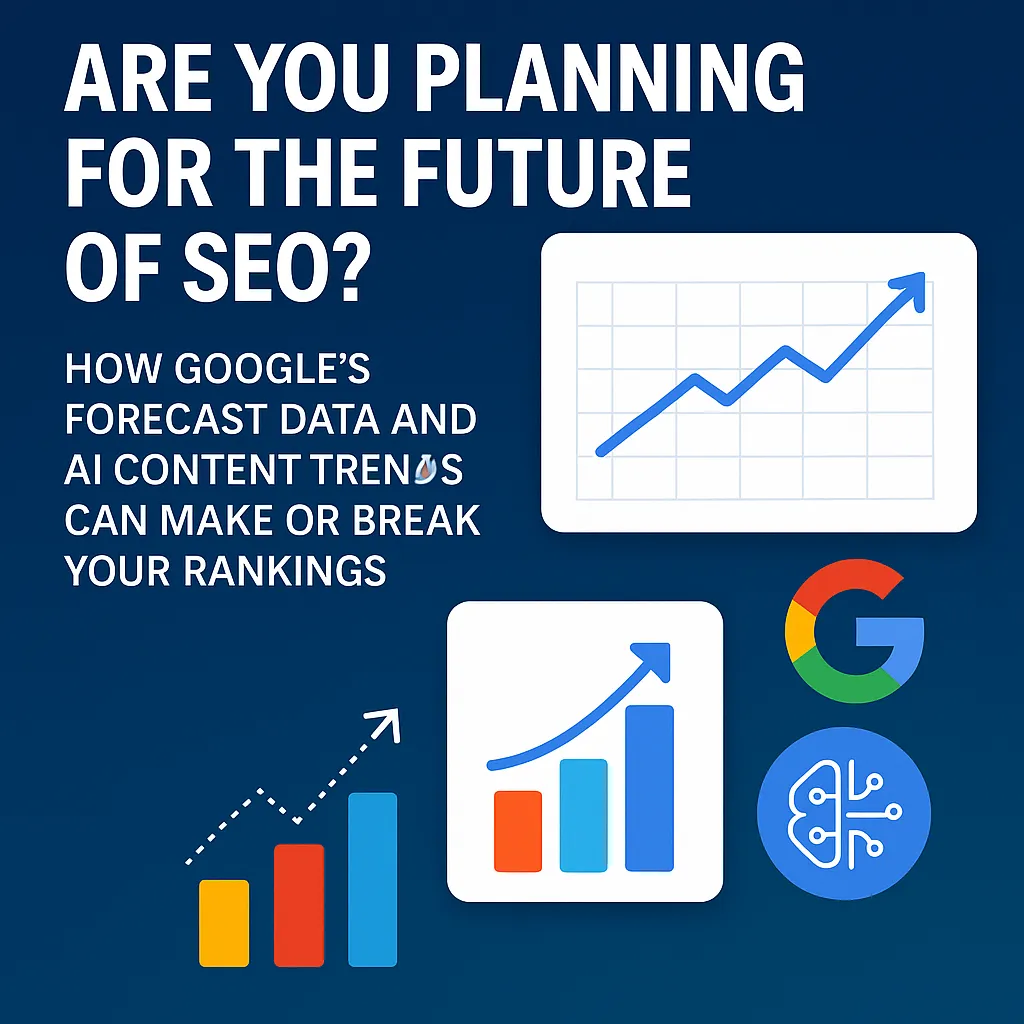
Are You Planning for the Future of SEO? How Google’s Forecast Data and AI Content Trends Can Make or Break Your Rankings
The world of SEO is changing faster than ever before. Between Google’s latest tools like Forecast Breakdowns in Keyword Planner and the rising impact of AI-generated content, marketers and businesses are finding themselves in uncharted territory.
To stay competitive and visible in search results, it’s no longer enough to follow traditional SEO practices. You need to adapt to data-driven forecasting AI and understand how content is viewed (and sometimes penalised) by search engines.
Let’s explore how both of these elements—forecast data and AI content trends—can either boost your rankings or set you back if not handled correctly.
🔍 What Are Forecast Breakdowns in Google Keyword Planner?
Google recently introduced Forecast Breakdowns to its Keyword Planner tool, giving advertisers and SEO professionals deeper insight into how keywords may perform in the future.
Key Features of Forecast Breakdowns:
Time-based predictions (weekly, monthly estimates)
Device-level insights (mobile vs. desktop performance)
Geographic breakdowns
CTR and CPC estimates for specific keyword groups
This allows SEO experts to predict the commercial viability of keyword clusters, making campaigns smarter and more targeted.
Why It Matters for SEO:
While Keyword Planner was historically focused on PPC, these new forecasting insights can help content marketers make more informed decisions about:
Which keywords are growing in interest
Seasonal keyword demand
Potential ROI of content based on search behavior trends
When combined with organic strategy, this allows SEO teams to plan smarter content calendars and invest in keywords that will matter tomorrow—not just today.
🤖 The Rise of AI-Generated Content in SEO
AI tools like ChatGPT, Jasper, and Copy.ai have made it incredibly easy to generate content at scale. But the question remains:
How does Google treat AI-generated content?
What Google Has Said:
Google isn’t outright against AI content—but it does penalize low-quality, unoriginal, or spammy AI-generated content. Its focus remains on EEAT:
Experience
Expertise
Authoritativeness
Trustworthiness
If your AI content lacks depth or seems mass-produced, it may get buried in search results. On the other hand, high-quality AI-assisted content that’s edited and enhanced by humans can still rank well.
📉 How AI Content Could Break Your Rankings
Overuse of Predictable Patterns
AI often creates generic intros, repetitive sentences, and vague conclusions. Search engines can detect and devalue this kind of content.Thin or Duplicate Content
If you're using AI to churn out multiple versions of the same topic, it could trigger duplicate content filters, reducing your visibility.Lack of First-Hand Experience
Google's Helpful Content Update favors articles that offer unique insight, opinions, and experience—something AI can’t fully replicate.Trust Signals Missing
Content that lacks authorship, sources, and factual depth is more likely to be flagged as untrustworthy by algorithms.
✅ How to Use AI Content the Right Way
Rather than relying on AI to write your blog posts or landing pages entirely, use it as a starting point. Here’s how:
AI for Structure, Humans for Storytelling
Let AI draft an outline, then fill in the gaps with case studies, expert opinions, and industry insight.Blend Data with Experience
Use real data (like Google’s forecast breakdowns) to validate the topics AI suggests or to add original charts/stats.Focus on EEAT
Always include real author bios, expert sources, and unique viewpoints to enhance credibility.
🔮 Merging Forecast Data and AI for Future-Proof SEO
Here’s how you can combine the power of forecasting and AI to stay ahead:
1. Use Forecast Data to Choose Topics
Identify rising keyword trends using Google’s forecast breakdowns, then create targeted content that aligns with upcoming demand.
2. Let AI Accelerate First Drafts
AI can help you build quick outlines, meta descriptions, or basic product pages—but never publish without human oversight.
3. Match Content Length with Keyword Intent
Forecast data often shows competition level and CPC—use this to decide whether a short-form or long-form post is needed.
4. Localise and Personalise Content
Forecasts can show which locations have keyword demand—use this to write geo-specific content that ranks better locally.
📌 Final Thoughts
The future of SEO lies at the intersection of data, automation, and authenticity.
Forecast tools like those in Google Keyword Planner are allowing marketers to see into the future of search demand.
AI tools are accelerating content production, but only human experience and trust can drive sustainable rankings.
If you want your content to perform, it’s time to combine strategic forecasting with smart, human-guided AI use. The businesses that strike this balance are the ones that will dominate search in the years ahead.
Need help aligning your content with future SEO trends?
A professional agency like Digital Junkies can help you decode forecast data, build intelligent keyword strategies, and leverage AI ethically to scale your digital growth.
Let the future work for you—not against you.